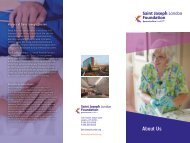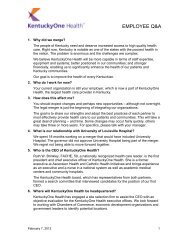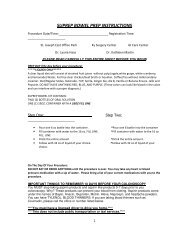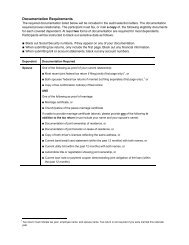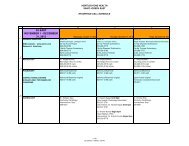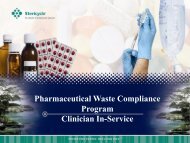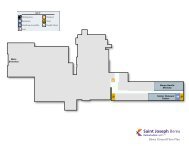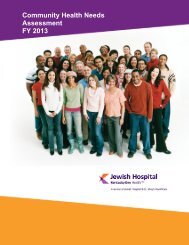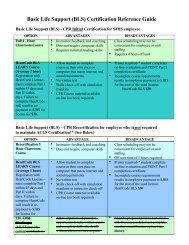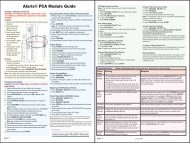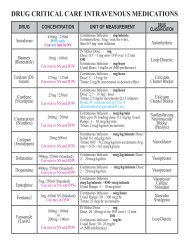Inpatient Blood Glucose Control Facts and Guidelines (For all ...
Inpatient Blood Glucose Control Facts and Guidelines (For all ...
Inpatient Blood Glucose Control Facts and Guidelines (For all ...
Create successful ePaper yourself
Turn your PDF publications into a flip-book with our unique Google optimized e-Paper software.
<strong>Inpatient</strong> <strong>Blood</strong> <strong>Glucose</strong> <strong>Control</strong> <strong>Facts</strong> <strong>and</strong> <strong>Guidelines</strong><br />
(<strong>For</strong> <strong>all</strong> patients who have diabetes or blood glucose control problems)<br />
ADMISSION:<br />
• General Points:<br />
<br />
<br />
<br />
<br />
<br />
<br />
<br />
In-hospital target blood glucose range:<br />
• Med/Surg/Telemetry areas = 70mg – 180mg<br />
• Critical Care units = 80 – 110mg<br />
Do not ignore the patient’s diabetes or hyperglycemia; even if it is not a primary diagnosis.<br />
Poor blood glucose control during hospitalizations increases infectious complications,<br />
organ damage, delays wound healing, <strong>and</strong> increases costs <strong>and</strong> length of stay.<br />
Distinguish between Type 1 <strong>and</strong> Type 2. Type 1 diabetes will ALWAYS require insulin<br />
injections even if NPO (to prevent ketosis).<br />
Assess for pre-admission diabetes medications <strong>and</strong> insulin, blood glucose meter use,<br />
history of diabetes complications.<br />
Explain to the patient that SJHC’s policy is to give insulin injections when blood glucose is<br />
>120mg; this does not mean the patient will go home on the insulin.<br />
Use the admission as a “teachable moment” <strong>and</strong> document <strong>all</strong> your teaching.<br />
Obtain a FSBG upon admission.<br />
In your history taking, always ask: if patient has been on insulin (not just pills); has a<br />
meter; verify Type 1 or Type 2; how long they have had diabetes; how often they check<br />
their FSBGs <strong>and</strong> what the FSBGS usu<strong>all</strong>y ran.<br />
Implement the <strong>Blood</strong> <strong>Glucose</strong> <strong>Control</strong> Protocol.<br />
• <strong>Blood</strong> <strong>Glucose</strong> <strong>Control</strong> Protocol<br />
Is to be implemented on ALL diabetes patients or patients without diabetes but have a<br />
blood glucose of >150.<br />
Can be implemented without a MD signature, but will need one by end of admission; so<br />
use a red ‘Sign Here’ sticker.<br />
It is not to be used on OPO/23hr admits, in OB, or patients with DKA.<br />
Orders #1 – 9 <strong>and</strong> #13 are to be taken off automatic<strong>all</strong>y; Orders #10 - #15 are orders<br />
that must be checked by the MD for individualization.<br />
It is important to get the A1C at admission because it can be altered by blood transfusions,<br />
iron treatment, or hemoglobinopathies.<br />
Implement the Hypoglycemia Protocol at the same time.<br />
• Hypoglycemia Protocol<br />
Must be started at the time of admission on <strong>all</strong> patients who are on the <strong>Blood</strong> <strong>Glucose</strong><br />
<strong>Control</strong> st<strong>and</strong>ing orders.<br />
General rule of thumb = about 15 grams of CHO will<br />
▲ increase FSBG by 25-50mg<br />
Do NOT over treat low blood glucose; take it one step at a time.<br />
Definition = any blood glucose less than 70mg/dl.<br />
If meal tray is available, feed patient immediately then check FSBG every 15-20 minutes<br />
until FSBG is greater than 70mg/dl. Treat as needed.<br />
Treat with 15 to 30gms carbohydrate (tablets or gel) every 15 to 20 minutes until FSBG<br />
greater than 70mg/dl.<br />
Severe Hypoglycemia = 40mg or less; treat with 1 amp D50; must get stat BG from Lab to<br />
confirm.<br />
If patient is NPO for surgery or procedure, may give Glutose gel up to 2 hours prior to<br />
surgery/procedure. If less than 2 hours prior to surgery/procedure, treat as if severe<br />
hypoglycemia.<br />
<br />
<br />
IM glucagon is used if severe hypoglycemia without IV access or if patient not willing or<br />
able to sw<strong>all</strong>ow; since glucagon can cause nausea <strong>and</strong> vomiting, remember to position the<br />
patient on his side to avoid aspiration.<br />
DOCUMENT – DOCUMENT – DOCUMENT!!!<br />
• <strong>Blood</strong> <strong>Glucose</strong> Monitoring<br />
Should be done AC & HS on most patients.<br />
<strong>For</strong> the first 48 hours, 0300 FSBG should also be done.<br />
If patient is NPO, on TPN or TF, then FSBG is q6h.<br />
Use the hospital’s Precision meter to check the FSBGs; if patient has brought in their<br />
own meter, explain we have to use our hospital meter since it documents the results.<br />
• Nutrition<br />
Goal = to achieve / maintain ideal body weight; FSBGs
<strong>Inpatient</strong> <strong>Blood</strong> <strong>Glucose</strong> <strong>Control</strong> <strong>Facts</strong> <strong>and</strong> <strong>Guidelines</strong><br />
•<br />
Scheduled insulin regimen every day is based on the previous day’s FSBG results. <strong>For</strong> example:<br />
Increase the following insulin: To Decrease the following FSBG:<br />
AM NPH<br />
Pre-supper<br />
PM Lantus/Levemir<br />
AM Fasting<br />
AM Regular/Novolog<br />
Pre-lunch<br />
PM Regular/Novolog<br />
Bedtime<br />
Total Daily Dose (TDD) of insulin<br />
The TDD is based on the total amount of Basal <strong>and</strong> Bolus (nutritional <strong>and</strong> meal<br />
time) insulin given in a 24 hour period.<br />
This helps to determine how much insulin the patient needs.<br />
• Basal Insulin (Lantus, Levemir, NPH)<br />
If A1C is greater than 9%, consider basal insulin.<br />
To figure the starting insulin dose, can use 0.5units/kg (range is 0.3 to 1.0 units/kg).<br />
50% of starting dose is the basal insulin; the other 50% is meal time insulin.<br />
Adjust insulin daily to attain glycemic goals.<br />
Consider IV insulin drip if unable to maintain FSBG less than 180mg/dl.<br />
• Nutritional (Meal time) Insulin<br />
Rapid acting insulin (Novolog, Humalog, or Apidra) is preferred.<br />
Only used for meal time <strong>and</strong> not for bedtime. It is held when patient is NPO.<br />
If patient does not eat meal, nutritional bolus should not be given.<br />
50% of starting dose is nutritional insulin, divided in thirds to be given at each meal.<br />
This insulin can be given from before to the end of the meal.<br />
If regular insulin is used, it is given 30 minutes before meal.<br />
Both correction <strong>and</strong> mealtime insulin can be given together.<br />
• Correction Insulin<br />
Rapid acting insulin (Novolog, Humalog, or Apidra) is preferred.<br />
Use of correction insulin alone is not recommended as it can lead to cycles of low<br />
<strong>and</strong> high FSBGs.<br />
If correction insulin is only being used, encourage MD to consider use of basal<br />
insulin <strong>and</strong> nutritional insulin.<br />
<strong>For</strong> most insulin sensitive patients, 1 unit of insulin will lower blood glucose by<br />
about 50mg/dl.<br />
Do not hold when FSBG is elevated (even if patient is NPO).<br />
The <strong>Blood</strong> <strong>Glucose</strong> <strong>Control</strong> Protocol has a weight based scale for correction insulin.<br />
Ide<strong>all</strong>y, it is better to individualize the treatment.<br />
To individualize treatment, a correction factor (CF) formula can be used:<br />
‣ 3000 divided by weight in Kg. OR, 1700 divided by the total daily insulin<br />
dose (TDD).<br />
‣ The CF is the amount of blood glucose that is lowered by one unit of insulin.<br />
‣ Example: 3000 divided by 90kg (TDD) = 33.3. Thus, one unit of insulin will<br />
lower BG by about 33mg/dl above the target blood glucose.<br />
ORAL DIABETES MEDICATIONS:<br />
• General Points:<br />
If FSBG is well controlled (within target BG range) can possibly remain on his home<br />
medications.<br />
If FSBG is not well controlled, best to use a basal/bolus insulin regimen in the<br />
hospital.<br />
If pill is in XL or XR form, do not break or crush.<br />
Check Creatinine <strong>and</strong> LFT levels as most can affect these lab tests.<br />
• Sulfonylureas:<br />
Amaryl (Glimepiride); Glucotrol (Glipizide); Diabeta (Micronase, Glyburide).<br />
Action = is an insulin secretagogue = it stimulates release of insulin from the<br />
pancreatic beta cells<br />
Should be taken before meals.<br />
Hypoglycemia is main side effect.<br />
Use with caution in renal <strong>and</strong> hepatic patients because they are metabolized<br />
hepatic<strong>all</strong>y <strong>and</strong> cleared ren<strong>all</strong>y.<br />
Action is with use of: NSAID’s, warfarin, salicylates, sulfonamides, <strong>all</strong>opurinol,<br />
probenecid, MAOI’s, chloramphenicol, alcohol, beta blockers.<br />
Action is with use of: steroids, diuretics, niacin, L-thyroxine, estrogens,<br />
progestins, phenytoin, diazoxide, INH, rifampin, phenothiazines, <strong>and</strong><br />
sympathominetics.<br />
These can be in combination form with Metformin.<br />
• Meglitinides (Non-Sulfonylurea Secretagogues):<br />
Pr<strong>and</strong>in (Repaglinide) <strong>and</strong> Starlix (Nateglinide).<br />
Action = Insulin secretagogue = stimulates release of insulin from pancreatic beta<br />
cells; Effect is mainly post-pr<strong>and</strong>ial.<br />
Give right at beginning of meal.<br />
Do not give if meal is skipped or patient is NPO.<br />
Use with caution in patients with liver disease.<br />
• Biguanides:<br />
Glucophage (Metformin) <strong>and</strong> the combinations.<br />
Action = Insulin sensitizer = decreases hepatic glucose production; increases<br />
peripheral glucose uptake <strong>and</strong> use; decrease intestinal absorption of glucose.<br />
Maximum dose is 2500mg.<br />
Give with food.<br />
Not recommended for use in patients >80years.<br />
Avoid use in hypoxic states, hepatic or renal insufficiency, CHF, or excessive alcohol<br />
use.<br />
Stop drug at time of contrast dye use <strong>and</strong> hold for 48 hours.<br />
After surgery, hold until oral intake is resumed <strong>and</strong> renal function is considered<br />
normal.<br />
• Alpha glucosidase inhibitors:<br />
Precose (Acarbose) <strong>and</strong> Glyset (Miglitol).<br />
Action = Delays the digestion of ingested carbohydrates by inhibiting digestive<br />
enzymes; Effect is mainly post-pr<strong>and</strong>ial FSBG.<br />
Main side effect is flatulence.<br />
Give with first bite of meals. If NPO, do not give.<br />
Treat hypoglycemia with glucose tablets or Gel only.<br />
• Thiazolidinediones (TZD):<br />
Av<strong>and</strong>ia (Rosiglitazone) <strong>and</strong> Actos (Pioglitazone).<br />
<br />
<br />
<br />
Action = Insulin sensitizer = increases glucose uptake <strong>and</strong> use <strong>and</strong> inhibits<br />
hepatic glucose production.<br />
Monitor liver function; can cause hepatatoxicity <strong>and</strong> fluid retention.<br />
Avoid use in class III <strong>and</strong> IV heart failure.<br />
Page
<strong>Inpatient</strong> <strong>Blood</strong> <strong>Glucose</strong> <strong>Control</strong> <strong>Facts</strong> <strong>and</strong> <strong>Guidelines</strong><br />
MISCELLANEOUS MEDICATIONS:<br />
• Byetta (Exenatide) (Used for Type 2 Diabetes)<br />
Action = GLP-1 receptor agonist; mimics action of gut incretin hormone stimulating<br />
insulin secretion; suppresses glucagon secretion; delays gastric emptying; promotes<br />
satiety.<br />
Is used with Glucophage &/or Sulfonylureas; it is not a substitute for insulin. Comes in<br />
injection form.<br />
If forgot to take, skip that dose (can not be taken later).<br />
Most common side effect is nausea.<br />
Given via a pre-filled syringe (pen device).<br />
Patient has to bring in own Byetta; this is not on SJHC formulary.<br />
Is taken before morning <strong>and</strong> evening meals.<br />
• Symlin (Pramlintide) (Used in Type 1 or Insulin requiring Type 2)<br />
Action = analog of pancreatic hormone Amylin; enhances the way insulin works;<br />
suppresses glucagon secretion; delays gastric emptying; promotes satiety.<br />
Comes in injection form to be given before meals; Is used with insulin.<br />
If forgets to take, skip that dose (can not be taken later).<br />
Most common side effect is nausea.<br />
Patient has to bring in own Symlin; this is not on SJHC formulary.<br />
• Januvia (Sitagliptin)<br />
Action = DPP-4 Inhibitor = Blocks the breakdown of the GLP-1 intestinal hormone to<br />
enhance the body’s own ability to lower elevated blood glucose.<br />
Is given only once a day.<br />
Hypoglycemia is not gener<strong>all</strong>y a problem.<br />
Dose adjustment needed if renal insufficiency or ESRD.<br />
• Inhaled Insulin (Exubera)<br />
Is a rapid-acting insulin that is breathed in before meals through an inhaler.<br />
MD order is needed in order for patient to use own inhaler; if patient did not bring inhaler<br />
in, an order for nutritional SQ insulin will be needed.<br />
Contraindicated in patients who smoke or have COPD.<br />
OTHER DRUG INTERACTIONS:<br />
Drugs that may raise blood glucose levels:<br />
Amprenavir Megestrol<br />
Aripirazole Nelfinavir<br />
Atazanavir Niacin/Nicotinic Acid<br />
Chlorpromazine Nortriptyline<br />
Clozapine Norvir<br />
Corticosteroids Olanzapine<br />
Diuretics<br />
Phenobarbitol<br />
Diazoxide Phenylephrine<br />
Didanosine Phenytoin*<br />
Epinephrine Pseudoephedrine<br />
Estrogens Quetiapine<br />
Fosamprenavir Respiradone<br />
Furosemide Rifampin*<br />
Haloperidol Ritonavir<br />
Indinavir<br />
Saquinavir<br />
Isoniazid<br />
Thiazide diuretics<br />
Lithium<br />
Thyroid (dessicated, synthetic)<br />
Lopinavir Ziprasodone<br />
Drugs that may lower blood glucose levels:<br />
Atenolol* ** Gatifloxacin*<br />
Amitriptyline* Gemfibrozil*<br />
Anabolic steroids Gemifloxacin*<br />
Aspirin*<br />
Imipramine*<br />
Bisoprolol* ** Levofloxacin<br />
Cimetidine* Methotrexate<br />
Ciprofloxacin* Methyldopa<br />
Chloramphenicol Metoprolol* **<br />
Clofibrate MAOIs<br />
Clomipramine* Nadolol* **<br />
Coumarin derivatives Nortriptyline*<br />
Darunavir Pinodolol* **<br />
Desipramine* Propanolol* **<br />
Esmolol* ** Propoxyphene<br />
Fenfluramine Quinine<br />
Fenofibrate* Sotalol* **<br />
Fluconazole* Sulfonamides*<br />
PERIOPERATIVE BLOOD GLUCOSE CONTROL:<br />
• Perioperative <strong>Blood</strong> <strong>Glucose</strong> <strong>Control</strong> protocol is used on <strong>all</strong> patients with diabetes who<br />
come through the OPS department only.<br />
• Surgery <strong>and</strong> procedures should preferably be scheduled for early AM to result in the<br />
least impact on FSBGs <strong>and</strong> insulin dosing.<br />
• FSBGs should be checked every 1 to 2 hours before, during, <strong>and</strong> after procedure.<br />
• Type 1 Diabetes needs insulin at <strong>all</strong> times even if NPO. Can become ketotic within 12<br />
– 24 hours if insulin held.<br />
• <strong>For</strong> Type 2 Diabetes on insulin, for the morning of surgery:<br />
Recommended to give ½ NPH insulin dose (will need order).<br />
If patient on bedtime Lantus or Levemir, can give usual dose.<br />
Do not give fast or short acting insulin unless FSBG >200.<br />
Consider starting IV insulin drip.<br />
• <strong>For</strong> Type 2 Diabetes on oral medications:<br />
<br />
Get order to hold sulfonylurea or other insulin secretagogues; to be resumed<br />
after patient eating.<br />
IV INSULIN INFUSIONS (only Regular insulin is used)<br />
• Comes pre-mixed from pharmacy; concentration is 1 unit per 1ml.<br />
• 2 nurses must verify <strong>and</strong> document rate changes for rates 10 units/hour or greater.<br />
• IV insulin only has a half life of about 5-10minutes once dc’d; therefore a SQ injection is<br />
needed before discontinuing drip:<br />
If regular insulin used, give 30 to 60 minutes before dc drip.<br />
If NPH, Lantus, or Levemir insulin used, give 2 hours before dc drip.<br />
<br />
<br />
Novolog or Humalog are not recommended as transition insulin.<br />
SQ transition insulin dose is determined based on 3 things:<br />
1. Action / Duration of SQ insulin to be given.<br />
2. How much IV insulin was given during the period of time equal to<br />
the duration of the SQ insulin to be given.<br />
3. When the next FSBG <strong>and</strong> insulin is to be given.<br />
• St<strong>and</strong>ard Insulin Drip<br />
May be adjusted every 1 to 2 hours.<br />
Used primarily for the med/surg units.<br />
Prior to stopping the drip, must give SQ insulin. When to give the insulin is<br />
based on when the insulin starts to work.<br />
• Critical Care Insulin Drip<br />
Should be adjusted hourly<br />
Only to be used in the Critical Care units<br />
Prior to stopping the drip, must give SQ insulin. When to give the insulin is<br />
based on when the insulin starts to work.<br />
Page
<strong>Inpatient</strong> <strong>Blood</strong> <strong>Glucose</strong> <strong>Control</strong> <strong>Facts</strong> <strong>and</strong> <strong>Guidelines</strong><br />
INSULIN PUMP MANAGEMENT:<br />
• Place the External Insulin Pump st<strong>and</strong>ing orders on the chart. It will need an MD signature.<br />
• Send a referral to the Diabetes Treatment Center for pump assessment.<br />
• Patient can manage his/her own pump if cognitively <strong>and</strong> physic<strong>all</strong>y OK.<br />
• If patient is not able to manage the pump, the pump is to be discontinued after a SQ insulin<br />
injection is given. Once dc’d, the pump is to be given to the patient’s family or to security.<br />
Document to whom the pump was given. Do NOT leave the pump in the patient’s room.<br />
• Verify that the patient has brought in their own pump supplies.<br />
• Insulin pumps deliver a continual, pre-set basal rate <strong>and</strong> provide the ability to give<br />
correction or meal time bolus.<br />
• The pump CANNOT be off for more than one hour without intervention.<br />
When the pump is off for brief periods as 1 to 4 hours, the amount of insulin that<br />
would have been given during that time, is to be given as a SQ injection.<br />
Do NOT remove the insulin cartridge from the pump while the infusion set is still<br />
attached to the patient.<br />
• X-RAYS = do NOT expose the pump to high electromagnetic fields as MRI, CT SCAN, or any<br />
X-rays.<br />
<br />
<br />
The pump is to be kept outside the room during the procedure.<br />
If you think the pump has been exposed, given SQ injection, disconnect the pump<br />
<strong>and</strong> c<strong>all</strong> the Diabetes Educator. If the Diabetes Educator is not available, c<strong>all</strong> the<br />
1-800 number on the back of the pump.<br />
DKA/HHS MANAGEMENT:<br />
• General Diagnostic Criteria: <strong>Glucose</strong> >250mg/dl; arterial pH



